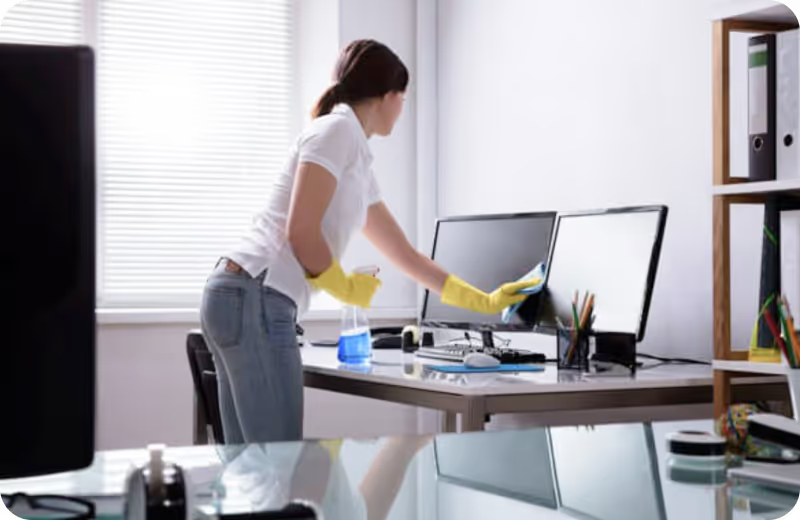
Commercial floors are high traffic areas as people come in and out of offices, stores, restaurants, and shops. Food spills can happen, as can spillage of dirt and debris. It is often considered a challenge to keep floors clean, even with microfiber mops. In this article, we'll show you how to clean different types of commercial flooring!
What You'll Need
You won't need any specialized equipment to clean your floors, as you can clean with a regular vacuum cleaner and mop. Depending on the type of flooring you have, you may need to get specially-formulated cleaning solutions, however, as not all flooring material is forgiving to regular cleaning solutions.
For instance, marble and natural stone are notorious for being incompatible with acidic solutions like vinegar and lemon juice. Instead, you can use a diluted solution of bleach and water, or use dish soap instead to clean the material. Hardwood floors, on the other hand, should not be bleached as it can remove the dyes.
Equipment
- Vacuum Cleaner
- Microfiber Mop
- Bucket
- Microfiber Towel
- Scrubbers
- Steam Cleaner (Optional)
Cleaning Solution
- All-purpose Floor Cleaner OR
- Dish Soap and Water Mixture
- Vinegar or Lemon Juice
- Baking Soda
- Essential Oils (Optional)
Cleaning Different Types of Flooring
How to Clean Floor Tiles
Most commercial tile floors are made with composite material that mimics stone, such as clay, alabaster, and bone ash. These are then sealed to protect against moisture, which makes them easy to clean with regular cleaning solutions.
Sweep or vacuum up the floors, then fill a large bucket with floor cleaner diluted with water. Dip a mop head into the solution, and wring out the excess solution. Use the damp mop to clean floors, adding more solution as the mop dries. Rinse out the mop between areas to remove grit and dirt. If your tiles have grout, scrub the grout with a small brush.
For any stains, use a stain removing paste made with vinegar or lemon juice, and baking soda. Test out the solution on a small, inconspicuous area first before using it over the floors to make sure that the material does not react to the acidity. The acid should lift the stain, while baking soda provides a scrubbing power, similar to abrasive cleaners but is more gentle.
How to Clean Hardwood Floors
The best method to clean your hardwood floors depends on the type of sealant used to protect the floors from stains and moisture. Unfinished floors tend to get dirty and warp easily, so take into account the sealant before deciding to clean it. It is also important to follow the wood grain while cleaning to remove dirt settled in the groves of the floors.
To keep hardwood floors clean, regularly sweep or vacuum the wood floors to remove excess dirt. Unfinished wood floors can have groves where dust can settle in, so it is important to scrub these out with a dry brush. Wood can also warp with moisture, so avoid cleaning the hardwood floor with a sopping wet mop.
Instead, consider using a spray mop, which dampens the floor with a cleaning solution without soaking it. Alternatively, you can use a regular mop, and keep a spray bottle filled with warm water and a couple of teaspoons of mild dish soap to spray the area you're mopping as you clean the floors. Use a dry mop, clean cloth, or paper towel to dry the floors.
How to Clean Vinyl Flooring
Sponge mops are great for cleaning vinyl flooring as they glide on the smooth surface evenly, and can scrub out any tough stains from the surface. Dip your sponge mop in your preferred cleaning solution, which can be a commercial floor cleaner, or a homemade solution of a few drops of dish soap and water. You can also use diluted bleach, which has a more effective cleaning power.
Take a rinse bucket, and fill the bucket with water and your preferred cleaning solution. Use the mop to wipe the area clean, washing it in the bucket to remove excess dirt.
How to Remove Grout Haze
Grout haze often happens with new tile floors, or newly-renovated floors. These are excess grout that overflowed onto the tiles, and are fairly easy to remove when they have yet to cure. You won't need any specific chemicals or tools.
To remove grout haze from commercial tiles, you will need a scouring pad or other abrasive scrubber. Dip the pad in warm water, then scrub in a circular motion to remove the grout. The grout should come out easily. If not, make a solution of half water and half vinegar, and use this to remove grout haze.
How to Deep Clean Carpet Fibers
Carpets can be cleaned daily with a vacuum cleaner to remove dirt and dust, but this type of flooring needs to be deep cleaned at least once every few months. Frequent cleaning will help maintain the texture of the carpet, remove allergens, and refresh the carpet fibers especially after they've been stomped on.
To deep clean carpet fibers, you will need a no-rinse carpet shampoo as these do not leave soapy residue. Wash the carpet with the carpet cleaning solution, and use a wet and dry vacuum to remove excess moisture. Keep washing until the color of the dirty water becomes clear, then leave the carpet to completely air dry.
For regular cleaning, make a cleaning powder with baking soda and essential oils, and sprinkle this mixture all over the carpet before vacuuming. To disinfect your carpet, you can use a steam to instantly kill germs, mold, and mildew.
Cleaning Floors Professionally
There is no better way to clean office floors than with professional cleaning services from Luce SG. Our cleaners are experienced; they are trained to know the different flooring materials, and how to clean them, so you can be sure we'll get your floors properly clean! Don't stress the mess, and focus on achieving workplace goals as we handle the office cleaning for you.
Give us a call, or email us to discuss a cleaning schedule with our team!


























